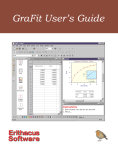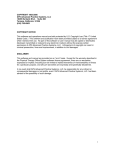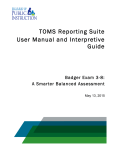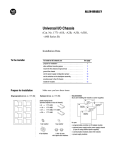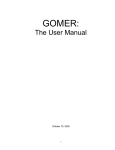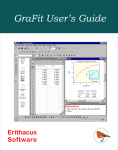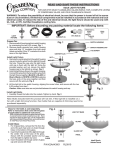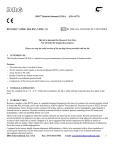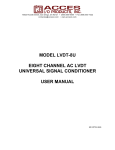Download "user manual"
Transcript
MT BindingSim Version 0.14 Julia Philip,1 Charles Pence,2 Holly Goodson1 MTBindingSim is a program to plot binding curves under various conditions, particularly those encountered in microtubule binding or other polymer binding situations. MTBindingSim is licensed under the GNU General Public License, and its documentation is licensed under the Creative Commons CC-BY-SA 3.0 License. 1 University 2 University of Notre Dame, Department of Chemistry and Biochemistry of Notre Dame, Program in History and Philosophy of Science C ONTENTS 1 Getting Started 1.1 Running MTBindingSim for the First Time . . . . . . . . . . . . . . . . . . . 2 Running MTBindingSim 2.1 Plotting Options . . . . . . . . . . . . . . . 2.1.1 Experimental Method . . . . . . . 2.1.2 Plotting Mode . . . . . . . . . . . . 2.1.3 X-axis . . . . . . . . . . . . . . . . . 2.1.4 Number of Points . . . . . . . . . . 2.2 Binding Models . . . . . . . . . . . . . . . 2.2.1 First Order Binding . . . . . . . . 2.2.2 Seam and Lattice Binding . . . . . 2.2.3 MAPs Dimerize . . . . . . . . . . . 2.2.4 Pseudocooperativity . . . . . . . . 2.2.5 MAPs Bind MT-bound MAPs . . . 2.2.6 Two MAPs Bind MT-bound MAPs 2.2.7 Two Binding Sites . . . . . . . . . . . . . . . . . . . . . . . . . . . . . . . . . . . . . . . . . . . . . . . . . . . . . . . . . . . . . . . . . . . . . . . . . . . . . . . . . . . . . . . . . . . . . . . . . . . . . . . . . . . . . . . . . . . . . . . . . . . . . . . . . . . . . . . . . . . . . . . . . . . . . . . . . . . . . . . . . . . . . . . . . . . . . . . . . . . . . . . . . . . . . . . . . . . . . . . . . . . . . . . . . . . . . . . . . . . . . . . . . . . . . . . . . . . . . . . . . . . . . . . . . . . . . . . . . . . . . . . . . . . . . 8 8 8 9 9 10 10 10 11 11 12 12 13 14 How To 3.1 Editing and Saving Graphs . . . 3.1.1 Saving Graphs . . . . . . 3.1.2 Editing Graphs . . . . . . 3.2 Saving a Graph as a Spreadsheet 3.3 Comparing Two Curves . . . . . 3 4 4 4 . . . . . . . . . . . . . . . . . . . . . . . . . . . . . . . . . . . . . . . . . . . . . . . . . . . . . . . . . . . . . . . . . . . . . . . . . . . . . . . . . . . . . . . . . . . . . . . . . . . . . . . . . . . . . . . . . . . . . . . . . . . . . 15 15 15 15 16 16 Binding Model Mathematics 4.1 Polymer Nature of MT . . . . . . . 4.1.1 Concentration of MT . . . . 4.1.2 Binding Ratio . . . . . . . . 4.2 First Order Binding . . . . . . . . . 4.3 Seam and Lattice Binding . . . . . 4.4 MAPs Dimerize . . . . . . . . . . . 4.5 Pseudocooperativity . . . . . . . . 4.6 MAPs Bind MT-bound MAPs . . . 4.7 Two MAPs Bind MT-bound MAPs 4.8 Two Binding Sites . . . . . . . . . . . . . . . . . . . . . . . . . . . . . . . . . . . . . . . . . . . . . . . . . . . . . . . . . . . . . . . . . . . . . . . . . . . . . . . . . . . . . . . . . . . . . . . . . . . . . . . . . . . . . . . . . . . . . . . . . . . . . . . . . . . . . . . . . . . . . . . . . . . . . . . . . . . . . . . . . . . . . . . . . . . . . . . . . . . . . . . . . . . . . . . . . . . . . . . . . . . . . . . . . . . . . . . . . . . . . . . . . . . . . . . . . . . . . . . . . . . . . . . . . . 19 19 19 19 20 20 21 22 23 24 25 2 Contents 5 Troubleshooting 5.1 Downloading and Installation . . . . . . . . . . . . . . . . . 5.1.1 There are password-protected files in your ZIP file 5.1.2 I can’t open your ZIP file . . . . . . . . . . . . . . . 5.1.3 MTBindingSim doesn’t run . . . . . . . . . . . . . . 5.2 Graphing . . . . . . . . . . . . . . . . . . . . . . . . . . . . . 5.2.1 My graph doesn’t show up . . . . . . . . . . . . . . 5.2.2 My graph looks wrong . . . . . . . . . . . . . . . . 5.3 Saving Your Results . . . . . . . . . . . . . . . . . . . . . . . 5.3.1 I can’t save XLS files . . . . . . . . . . . . . . . . . . 5.4 Other . . . . . . . . . . . . . . . . . . . . . . . . . . . . . . . 5.4.1 I need help, can I contact the developers? . . . . . . 5.4.2 I think I’ve found a bug, how do I report it? . . . . 5.4.3 I have an idea for a great new feature! . . . . . . . . 5.5 Filing a Support Ticket . . . . . . . . . . . . . . . . . . . . . . . . . . . . . . . . . . . . . . . . . . . . . . . . . . . . . . . . . . . . . . . . . . . . . . . . . . . . . . . . . . . . . . . . . . . . . . . . . . . . . . . . . . . . . . . . . . . . . . . . . . . . . . . . . . . . . . . . . . . . . . . . . . . . . . . . . . . . . . . . . 26 26 26 26 26 26 26 27 27 27 27 27 27 27 27 6 Contact Us 29 7 Acknowledgements 30 A MTBindingSim Revision History A.1 Version 0.14 . . . . . . . . . . A.2 Version 0.13 . . . . . . . . . . A.3 Version 0.12 . . . . . . . . . . A.4 Version 0.11 . . . . . . . . . . A.5 Version 0.10 . . . . . . . . . . A.6 Version 0.9 . . . . . . . . . . . A.7 Version 0.8.1 . . . . . . . . . . A.8 Version 0.8 . . . . . . . . . . . A.9 Version 0.7 . . . . . . . . . . . A.10 Version 0.6.1 . . . . . . . . . . A.11 Version 0.6 . . . . . . . . . . . A.12 Version 0.5 . . . . . . . . . . . . . . . . . . . . . . . . . . . . . . . . . . . . . . . . . . . . . . . . . . . . . . . . . . . . . . . . . . . . . . . . . . . . . . . . . . . . . . . . . . . . . . . . . . . . . . . . . . . . . . . . . . . . . . . . . . . . . . . . . . . . . . . . . . . . . . . . . . . . . . . . . . . . . . . . . . . . . . . . . . . . . . . . . . . . . . . . . . . . . . . . . . . . . . . . . . . . . . . . . . . . . . . . . . . . . . . . . . . . . . . . . . . . . . . . . . . . . . . . . . . . . . . . . . . . . . . . . . . . . . . . . . . . . . . . . . . . . . . . . . . . . . . . . . . . . . . . . . . . . . . . . . . . . . . . . . . . . . . . . . . . . . . 31 31 31 31 31 31 31 31 31 32 32 32 32 3 1. G ETTING S TARTED Thanks for checking out MTBindingSim! Here’s a quick-start tutorial designed to get you graphing binding curves in no time. 1.1. Running MTBindingSim for the First Time To begin, you will need to download and install MTBindingSim. When you run MTBindingSim for the first time, you should see a window that looks like this: 4 Chapter 1. Getting Started MTBindingSim’s defaults are to plot a graph of an experiment in which the total concentration of microtubules, [MT], is varied (along the X-axis), and the binding model is first-order binding. See the Running MTBindingSim chapter for more information about these settings, and the Binding Model Mathematics chapter for more detailed information about the binding models. First, enter values for the experimental range of [MT]. Varying between 0 and 10 is a nice start. You will also need to enter values for [A] total, KD , and the binding ratio. Try 2 for both [A] total and KD , and leave the binding ratio at its default of 1. To calculate the binding curve under these conditions, click the graph button. You should now see a graph that looks like this: 5 Chapter 1. Getting Started Congratulations, you’ve just plotted your first binding curve using MTBindingSim! Try changing the values of [A] total, KD , or the binding ratio to see how the curves change. After plotting four curves you’ll have a graph that might look something like this: 6 Chapter 1. Getting Started If you’d like to start over with a new graph, click the clear button. This will delete the current graph, and subsequent curves will be plotted on a new plot. For more detailed information about what you can do with MTBindingSim, see the Running MTBindingSim and How To. . . chapters. If you have any trouble, see the Troubleshooting section. Good luck, and happy graphing! 7 2. R UNNING MTB INDING S IM To plot a graph using MTBindingSim, select the plotting options and binding model you would like to use, enter the parameters you want, and click the graph button. This section explains what plotting options and binding models are available. 2.1. Plotting Options There are serveral sets of plotting options that can be selected. These options will apply to all graphed curves. 2.1.1. Experimental Method There are three available experimental methods. Curves from different experimental methods cannot be plotted on the same graph, so changing the experimental method will automatically close an active graph. In all methods A is an MT binding protein. The concentration of MT is taken as the concentration of polymerized tubulin dimers, as is common in MT literature. MT binding experiments are generally performed with MT stabilizers so that the concentration of polymerized tubulin can be taken as the total concentration of tubulin present. Vary [MT]: In this method, the concentration of A is held constant and the concentration of MT is varied. The fraction of A bound is graphed on the y-axis. This is a “standard” binding experiment and simulates data from many standard experimental methods of measuring binding data, including SPR, fluorescence anisotropy, and tryptophan fluorescence, as well as cosedimentation assays. Vary [A]: In this method, the concentration of MT is held constant and the concentration of A is varied. The concentration of A bound is graphed on the y-axis. This kind of data cannot be collected using many standard binding assays such as SPR and fluorescence anisotropy, but it can be collected using a cosedimentation assay. Competition: In this method, there are two MT binding proteins, A and B. The concentration of A and the concentration of MT are held constant while the concentration of B is varied. The fraction of A bound is plotted on the y-axis. This kind of data can be collected with many standard methods of measuring binding data, such as SPR, fluorescence anisotropy, tryptophan fluorescence, and cosedimentation assays. 8 Chapter 2. Running MTBindingSim 2.1.2. Plotting Mode MTBindingSim can plot one curve at a time or it can plot two curves simultaneously and compare them. You may plot as many curves as you wish as long as you don’t change the experimental method or X-axis settings. However, only two curves may be directly compared by the program. For more information about comparing two curves see the How To section. 2.1.3. X-axis In Vary [MT] mode, the X-axis can be set to either [MT] total or [MT] free. [MT] total is a known quantity in the experiment, while [MT] free must be calculated. However, the familiar Langmuir Isotherm equation uses [MT] free as its independent variable, and the quick method of determining K D by looking at the MT concentration when the fraction of A bound is 0.5 only works if the x-axis is [MT] free. In either X-axis mode the Y-axis will be the fraction of A bound. In Vary [A] mode there are three possible kinds of plots. In the first two the Y-axis is the concentration of A bound to MT, and the X-axis can be set to [A] free or [A] total. In addition, the data can be plotted in a Scatchard plot, where the X-axis is [A] bound and the Y-axis is is [A] bound/[A] free. This kind of plot is used to make the binding data linear. Binding data will be linear for simple interactions and a curved line in a Scatchard plot indicates the presence of cooperativity or other kinds of non-simple binding interactions. Changing the x-axis mode will automatically close the active graph. 9 Chapter 2. Running MTBindingSim 2.1.4. Number of Points The number of points plotted may be specified. The default number of points is 100. A larger number of points can be used if a smoother curve is desired. A smaller number of points will result in a faster calculation. 2.2. Binding Models MTBindingSim can plot curves for several binding models. For a detailed description of the math used to generate the curves, please see the Binding Model Mathematics chapter. Note that all models use the dissociation constant, KD . The info button to the right of the model selection box provides a brief description of each model, reproduced below. First order binding: Simple A binds MT interaction. This model is valid for any simple protein-protein or potein-ligand interaction. Seam and lattice binding: A binds to the MT seam (1/13 of the MT) with a different affinity from the MT lattice (12/13 of the MT). This model is valid only for binding of proteins or ligands to 13-protofilament MTs with a seam. MAPs dimerize: A can bind to MT either as a monomer or as a dimer. This model is valid for any polymer-protein or polymer-ligand interaction. Pseudocooperativity: For every MT site that binds an A, another MT site is converted to an MT* site, which binds to A with a different dissociation constant. This model is applicable to polymer-protein or polymer-ligand interactions in which one binding event influences other binding events. MAPs bind MT-bound MAPs: A binds to MT and then another A can bind to each MT-bound A. This model is valid for any protein-protein or protein-ligand interaction in which one binding event reveals another binding surface. Two MAPs bind MT-bound MAPs: A binds to MT and then two As can bind to each MT-bound A. This model is valid for any protein-protein or protein-ligand interaction in which one binding event reveals another binding site. This is an extension of the MAPs bind MT-bound MAPs model. Two binding sites: A can bind to two sites on each MT. This model is valid for any protein-protein or protein-ligand interaction with two independent binding sites. 2.2.1. First Order Binding First order binding simulates binding under standard first order conditions where one A interacts with one MT dimer, and all A-MT interactions are identical. 10 Chapter 2. Running MTBindingSim For first order binding, you need to input the total concentration of A (or MT), the KD , and the binding ratio. All of these must be positive numbers. 2.2.2. Seam and Lattice Binding Seam and lattice binding simulates a scenario in which protein A binds to the MT seam dimers with a different affinity than the MT lattice dimers. For this model you need to input the total concentration of A (or MT), the dissociation constants for the seam, KS , lattice, KL , and the binding ratio. All inputs must be positive numbers. 2.2.3. MAPs Dimerize In this model, A can exist either as a monomer or as a dimer, and both the monomer and dimer forms can bind to MT. 11 Chapter 2. Running MTBindingSim For this model, you need to input the total amount of A (or MT), the dissociation constant for monomeric A binding MT, K1 , the dissociation constant for dimeric A binding MT, K2 , the dissociation constant for the A dimer, KA , and the binding ratio. All inputs must be positive numbers. 2.2.4. Pseudocooperativity This model simulates a situation where the binding of an A to an MT site changes the conformation of another MT site, creating an MT* site which has a different affinity for A than the MT sites. For this model, you need to input the total amount of A (or MT), the dissociation constant for A binding to MT, KAMT , the dissociation constant for A binding to MT*, KAMT *, and the binding ratio. All inputs must be positive numbers. 2.2.5. MAPs Bind MT-bound MAPs In this model, once one A has bound to an MT dimer, another A can bind to it without taking up another MT binding site. 12 Chapter 2. Running MTBindingSim For this model, you need to input the total concentration of A (or MT), the dissociation constant for A binding to MT, KM , the dissociation constant for A binding to MT-bound A, KA , and the binding ratio. All inputs must be positive numbers. 2.2.6. Two MAPs Bind MT-bound MAPs In this model, once one A has bound to the MT, two more As can bind to it without taking up additional MT binding sites. For this model, you need to input the total concentration of A (or MT), the dissociation constant for A binding to MT, KM , the dissociation constant for A binding to MT-bound A, KA , and the binding ratio. All inputs must be positive numbers. This model can be used in concert with the MAPs bind MT-bound MAPs model described above to begin to understand the behavior of MAPs that use the MT as a nucleation site for MAP polymerization. It is impractical to model a case where the MAP can form a large polymer, but these two models together establish the trend of the binding data in such a case. 13 Chapter 2. Running MTBindingSim 2.2.7. Two Binding Sites In this model, A can bind to two sites per tubulin dimer, site 1 and site 2 with different dissociation constants. In this model, you input the total amount of A (or MT), the dissociation constant for A binding to MT1 sites, KAMT1 and the dissociation constant for A binding to MT2 sites, KAMT2 . All inputs must be positive numbers. Note that the total amount of MT is the total amount of MT1 and MT2 . This model cannot be graphed with an x-axis of [MT] free. 14 3. H OW TO This chapter explains how to use some of the advanced features of MTBindingSim. 3.1. Editing and Saving Graphs 3.1.1. Saving Graphs To save a graph generated by MTBindingSim for later use or editing click on the save graph button. You can save your figure in the following formats: • • • • • • • • • MATLAB figure (.fig) Adobe Illustrator file (.ai) EPS file (.eps) JPEG image (.jpg) Portable Document Format (.pdf) Portable Network Graphics file (.png) TIFF image (.tif) Excel spreadsheet (.xls) Comma separated value table (.csv) If you wish to embed your figure in a PowerPoint presentation or a Word document, the best choice is probably a JPEG image. If you wish to include your figure in a LaTeX document, you should probably save it either as a PDF file or as an EPS file. Finally, if you wish to edit the graph, changing text or other graph properties, it is recommended to save the graph either in Adobe Illustrator format (if you have access to Illustrator), or in PNG format (for editing in any image editing software, including Photoshop). If you’d like to save the curves as x and y values in a spreadsheet, see “Saving a Graph as a Spreadsheet” below. 3.1.2. Editing Graphs The graphs generated by MTBindingSim can be edited in several ways. From inside the program, you can change the location of the legend box by clicking and dragging. You also can edit the legend text by double-clicking on it. If you would like to see a particular part of the graph blown up, you can use the zoom in and out tools on the graph window, and then the hand tool to drag the graph to the desired region. To edit the graph more extensively, two options are available. If you have MATLAB, you can save the graph as a MATLAB Figure (.FIG) file, and edit it as you would any other MATLAB graph. Otherwise, it is recommended to save as an Adobe Illustrator 15 Chapter 3. How To (.AI) file, and edit in Adobe Illustrator. You may also be able to edit an Illustrator file in the open-source Inkscape image editor. 3.2. Saving a Graph as a Spreadsheet To save the curves from a graph as x and y values in a spreadsheet, click on the save graph button in MTBindingSim. Saving as an Excel file (.xls) will generate an Excel file containing the x and y values for all curves on the graph. Saving as a comma separated value file (.csv) will create a CSV table with the x and y values for all curves on the graph. If you are running MTBindingSim in Mac OS X or Linux, you cannot save your files as .xls. You can save them as .csv files and then open them in Excel. Please see Troubleshooting for more information. 3.3. Comparing Two Curves To compare two curves in MTBindingSim, first select “compare two curves” from the plotting mode box. This will cause a second model selection drop down box and set of model parameter input boxes to appear. Enter the parameters for the curves you wish to compare in the two columns. The curves are independent of each other. An example of two curves to be compared is below. 16 Chapter 3. How To When you click the graph button, the curves will be plotted on the active graph or a new graph. 17 Chapter 3. How To If the X-axis is plotting total [MT] or total [A], or in competition mode he program also will calculate the difference between the two curves and display the result. These values are calculated by computing the absolute and percentage difference between the curves at each point, and both the average and largest difference are reported for each. This feature is designed to help researchers determine whether the predicted differences between two curves are detectable given their expected experimental error. This comparison is only done for curves plotted with the X-axis as [MT] total or [A] total because the x-values for both curves are the same in that case, so the comparison calculations are unambiguous. When the X-axis is [MT] free or [A] free the x-values for the curves will be different and the calculation of a comparison between the curves requires making assumptions about the binding behavior. 18 4. B INDING M ODEL M ATHEMATICS This chapter describes the equations used to simulate the binding curves. Though some of these equations can be solved analytically, the calculations are performed numerically. The program breaks either the total [A] or total [MT] range into a user-defined number of points and then calculates the concentration of free and bound A and free and bound MT at each point. 4.1. Polymer Nature of MT Microtubules are polymers composed of tubulin dimers consisting of one alpha and one beta tubulin. A microtubule is formed by 13 filaments of tubulin dimers binding head to tail. For most of the microtubule, the lateral interactions are alpha-beta, but one set of interactions (the MT “seam”) is alpha-alpha and beta-beta. For most binding calculations the polymeric nature of the MT can be ignored, however, in a few cases it must be taken into account, as described below. 4.1.1. Concentration of MT By convention, the concentration of MT is reported as the concentration of tubulin dimers. In most binding assays a microtubule stabilizer is used to make the concentration of free tubulin irrelevant in binding calculations. Should this not be the case, the contribution of free tubulin dimer both in decreasing the available polymer sites and in possibly competing with the polymerized tubulin for binding proteins must be taken into account. MTBindingSim does not deal with such cases. 4.1.2. Binding Ratio Some MT binding proteins appear to bind to MT with ratios other than 1 MT binding protein : 1 tubulin dimer. Ackmann et. al. have introduced the binding ratio, n, as an additional parameter that can be used in fitting binding data to accommodate non 1:1 binding ratios. We have included the binding ratio n as a parameter that can be set in our binding curve calculations. Following Ackmann et. al., we have defined n such that that binding ratio is n A : 1 tubulin dimer. However, we have differed from Ackmann et. al. in how we include the binding ratio in our binding equations. While they change the number of available binding sites based on the binding ratio, we do not change the number of available sites. We account for the binding ratio only in the mass balance for microtubules. This formulation assumes that the number of available binding sites is the number of free dimers, regardless of how many dimers an individual A binds. This method will break down in an extreme boundary case where a single A binds so many tubulin dimers that a single MT polymer does not contain enough sites. In such a case, A would need to encounter two or more individual MT polymers, changing 19 Chapter 4. Binding Model Mathematics the binding model. However, such an extreme case is extraordinarily rare and would most likely occur if two different polymers were interacting with each other directly. MTBindingSim does not deal with such cases. 4.2. First Order Binding This model is simple first order binding. K AMT In first order binding, the relationship between A and MT is: A + MT AMT. The dissociation constant is defined as: [ A][ MT ] K AMT = [ AMT ] . We can also write mass balances for total A and total MT: [ A]total = [ A] + [ AMT ] = [ A] + K 1 [ A][ MT ] AMT 1 [ MT ]total = [ MT ] + [ AMT ]/n = [ MT ] + K AMT n [ A ][ MT ] = [ MT ](1 + We can rearrange the equation for total MT and solve for [MT] free: [ MT ] = [ MT1]total . 1+ K AMT n 1 K AMT n [ A ]). [ A] We now can substitute this equation into the equation for total A: [ A]total = [ A] + 1 K AMT [ A][ MT ]total 1+ K 1 [ A] AMT n . The program numerically finds the value of [A] free that solves this equation, then uses that to calculate all other necessary parameters. 4.3. Seam and Lattice Binding In the seam and lattice binding model, it is assumed that there are two different kinds of binding sites on the MT: seam sites and lattice sites, which have different dissociation constants. The seam sites are 1/13 of the total MT and the lattice sites are 12/13 of the total MT. 20 Chapter 4. Binding Model Mathematics K AL K AS The binding relationship is: A + S AS, A + L AL. The disocciation constants for these interactions are: K AS = [ A][S]/[ AS], K AL = [ A][ L]/[ AL]. We can write a mass balance for all three species: [ A]total = [ A] + [ AS] + [ AL] = [ A] + K1 [ A][S] + K1 [ A][ L] AS AL 1 1 [S]total = [S] + [ AS]/n = [S] + K AS n [ A ][ S ] = [ S ](1 + K AS n [ A ]) 1 1 [ L]total = [ L] + [ AL]/n = [ L] + K AL n [ A ][ L ] = [ L ](1 + K AL n [ A ]). We now can solve for free L and free S: [S] = [S]1total 1+ K [ L] = [ A] AS n [ L]total . 1+ K 1 n [ A ] AL We now can plug these values into the equation for total A: [ A]total = [ A] + 1 K AS [ A ][ S ]total 1+ K 1 n [ A ] AS + 1 K AL [ A ][ L ]total 1+ K 1 n [ A ] AL . This equation is numerically solved for free A and the result is used to calculate bound A and free and total MT. 4.4. MAPs Dimerize In this model, A can form a dimer with itself, and can bind to the MT in both the monomeric and dimeric forms with different disocciation constants. 21 Chapter 4. Binding Model Mathematics K AMT K AAMT K AA The binding interaction for this model is: A + A A2 , A + MT AMT, A2 + 2MT A2 MT2 . The disocciation constants for these interactions are: K AA = [ A][ A]/[ A2 ], K AMT = [ A][ MT ]/[ AMT ], K AAMT = We can write mass balances for A and MT: [ A]total = [ A] + 2[ A2 ] + [ AMT ] + 2[ A2 MT2 ] = [ A] + K 2 [ A]2 + K 1 [ A][ MT ] + K 2 [ A2 ][ MT ] AA AMT [ A2 ][ MT ] . [ A2 MT2 ] AAMT 2 1 = [ A] + K AA [ A]2 + K AMT [ A][ MT ] + K AMT2 K AA [ A]2 [ MT ], [ MT ]total = [ MT ] + [ AMT ]/n + 2[ A2 MT2 ]/n 2 1 = [ MT ] + K AMT n [ A ][ MT ] + K AAMT n [ A2 ][ MT ] 2 1 2 = [ MT ] + K AMT n [ A ][ MT ] + K AAMT K AA n [ A ] [ MT ] 1 2 2 = [ MT ](1 + K AMT n [ A ] + K AAMT K AA n [ A ] ). We can now solve the MT mass balance for free MT to get: [ MT ]total [ MT ] = . 1 2 2 1+ K AMT n [ A]+ K AAMT K AA n [ A] We can plug this into the mass balance for A: [ A]total = [ A] + 2 2 K AA [ A ] + 1 K AMT [ A ] + 2 2 K AAMT K AA [ A ] 1+ K [ MT ]total 1 2 [ A]+ K [ A ]2 n AMT AAMT K AA n . This equation is numerically solved by the program for free A and the result is used to calculate bound A and free and bound MT. 4.5. Pseudocooperativity Cooperative binding of MAPs cannot be modeled using the standard model of cooperative ligand binding. To model cooperative behavior we have implemented a “pseudocooperativity” model where the binding of an A to an MT site, with an affinity of KAMT , creates an MT* site, which has an affinity of KAMT * for A. MT* sites are created by the binding of A to both MT and MT* sites, so the total number of MT* sites is equal to the total number of bound A proteins. The binding relationships are: A + MT AMT, A + MT ∗ AMT ∗ . The dissociation constants for these interactions are: 22 Chapter 4. Binding Model Mathematics K AMT = [ A][ MT ]/[ AMT ], K AMT ∗ = [ A][ MT ∗]/[ AMT ∗]. We can write mass balances for this situation. Note that there is an additional mass balance for MT*. [ MT ∗]total = [ MT ∗] + [ AMT ∗] = [ AMT ] + [ AMT ∗] This equation can be used to show that [MT*] = [AMT], which we will use later. [ A]total = [ A] + [ AMT ] + [ AMT ∗] = [ A] + [ AK][ MT ] + [ AK][ MT∗∗] = [ A][ MT ] K AMT [ A][ AMT ] [ A][ MT ] K AMT ∗ = [ A ] + K AMT 2 A] + K AMT[ AK]AMT ∗ ) [ A] + [ MT ]( K[AMT = [ A] + + AMT + [ A][ A][ MT ] K AMT K AMT ∗ AMT [ MT ]total = [ MT ] + [ AMT ] + [ MT ∗] + [ AMT ∗] = [ MT ] + [ AMT ] + [ AMT ] + [ AMT ∗] ][ MT ] MT ∗] = [ MT ] + 2[ AMT ] + [ AMT ∗] = [ MT ] + 2[KAAMT + [ AK][AMT ∗ [ A][ AMT ∗] 2[ A][ MT ] = K AMT + K AMT 2[ A ] [ A][ A] [ MT ](1 + K AMT + K AMT K AMT ∗ ) = [ MT ] + = [ MT ] + 2[ A][ MT ] K AMT + [ A][ A][ MT ] K AMT K AMT ∗ The MT mass balance can be solved for free MT as follows: [ MT ]total . [ MT ] = [ A ]2 2[ A ] 1+ K AMT +K AMT K AMT ∗ This equation can then be substituted into the mass balance for A to get: [ A]total = [ A] + [ A ]2 ) AMT AMT K AMT ∗ 2 2[ A ] 1+ K + K [ AK] AMT AMT AMT ∗ [ MT ]total ( K [ A] + K This equation is solved numerically by the program to calculate A bound and free and MT bound and free at each point. 4.6. MAPs Bind MT-bound MAPs In this model, A binds MT with a disocciation constant of KAMT ; then, another A can bind the bound A with a disocciation constant of K AA . K AMT K AA The binding relationships are: A + MT AMT, A + AMT A2 MT. The dissociation constants for these interactions are: K AMT = [ A][ MT ]/[ AMT ], K AA = [ A][ AMT ]/[ A2 MT ]. We can write the mass balances for this situation: 23 Chapter 4. Binding Model Mathematics 1 1 [ A]total = [ A] + [ AMT ] + 2[ A2 MT ] = [ A] + K AMT [ A][ MT ] + K AA [ A][ AMT ] 1 1 2 = [ A] + K AMT [ A][ MT ] + K AMT K AA [ A] [ MT ] 1 1 2 [ MT ]total = [ MT ] + [ AMT ]/n + [ A2 MT ]/n = [ MT ] + K AMT n [ A ][ MT ] + K AMT K AA n [ A ] [ MT ] 1 1 2 = [ MT ](1 + K AMT n [ A ] + K AMT K AA n [ A ] ). We can solve the MT mass balance for free MT as follows: [ MT ]total . [ MT ] = 1 1 2 1+ K AMT n [ A]+ K AMT K AA n [ A] We can then substitute this equation intothe A mass balance to get: [ A]total = [ A] + 1 1 2 K MT [ A ] + 2 K AMT K AA [ A ] 1+ K [ MT ]total 1 1 [ A]+ K [ A ]2 n AMT AMT K AA n . This equation is numerically solved by the program to find the value of free A, which is used to calculate bound A and free and bound MT. 4.7. Two MAPs Bind MT-bound MAPs This model is very similar to the MAPs bind MT-bound MAPs model, except in this case two layers of bound MAP are possible on top of an MT-bound MAP. K AA K AMT K AA The binding relationships for this model are: A + MT AMT, A + AMT A2 MT, A + A2 MT A3 MT. The disocciation constants for this model are: K AMT = [ A][ MT ]/[ AMT ], K AA = [ A][ AMT ]/[ A2 MT ], K AA = [ A][ A2 MT ]/[ A3 MT ]. Note that the disocciation constant for the first and second MAP binding to the MTbound MAP is the same. The mass balances for this model are: [ A]total = [ A] + [ AMT ] + 2[ A2 MT ] + 3[ A3 MT ] = [ A] + K 1 [ A][ MT ] + K 2 [ A][ AMT ] + K 3 [ A][ A2 MT ] AMT 1 AA AA 2 2 K AMT K AA [ A ] [ MT ] + = [ A] + K AMT [ A ][ MT ] + = [ A] + 1 2 2 K AMT [ A ][ MT ] + K AMT K AA [ A ] [ MT ] + 3 [ A]2 [ AMT ] K2AA 3 [ A]3 [ MT ], K AMT K2AA [ MT ]total = [ MT ] + [ AMT ]/n + [ A2 MT ]/n + [ A3 MT ]/n 1 1 1 2 = [ MT ] + K AMT n [ A ][ MT ] + K AMT K AA n [ A ] [ MT ] + K K2 AMT = [ MT ](1 + 1 1 2 K AMT n [ A ] + K AMT K AA n [ A ] + AA n [ A]3 [ MT ]. 1 [ A ]3 ). K AMT K2AA n 24 Chapter 4. Binding Model Mathematics Notice that, as with the MAPs bind MT-bound MAPs model, all MT-A complexes contain a single MT unit. The MT mass balance can be solved for free MT: [ MT ]total [ MT ] = . 1 1 1 2 3 1+ K AMT n [ A]+ K AMT K AA n [ A] + K AMT K2 n AA [ A] This can then besubstituted into the A mass balance equation, yielding: [ A]total = [ A] + 1+ K 1 2 2 K AMT [ A ] + K AMT K AA [ A ] [ MT ]total 1 1 1 [ A]+ K [ A ]2 + [ A ]3 n K AMT K2 n AMT AMT K AA n AA + 3 [ A ]3 K AMT K2AA · . This equation is numerically solved by the program to get free A. This is then used to calculate bound A and free and bound MT. 4.8. Two Binding Sites This model assumes that each tubulin dimer contains two binding sites for protein A, sites 1 and 2, with different dissociation constants. It is assumed that the two sites do not interact. The binding relationships for this model are: A + MT1 AMT1 , A + MT2 AMT2 . The dissociation constants for this model are: K AMT1 = [ A][ MT1 ]/[ AMT1 ], K AMT2 = [ A][ MT2 ]/[ AMT2 ]. The mass balances for this model are: [ A]total = [ A] + [ AMT1 ] + [ AMT2 ] = [ A] + [ A][ MT1 ]/K AMT1 + [ A][ MT2 ]/K AMT2 , [ MT1 ]total = [ MT1 ] + [ AMT1 ] = [ MT1 ] + [ A][ MT1 ]/K AMT1 = [ MT1 ](1 + [ A]/K AMT1 ), [ MT2 ]total = [ MT2 ] + [ AMT2 ] = [ MT2 ] + [ A][ MT2 ]/K AMT2 = [ MT2 ](1 + [ A]/K AMT2 ). The MT1 and MT2 mass balances can be solved for free MT1 and MT2 : 1 ]total , [ MT1 ] = 1+[[ MT A]/K AMT1 [ MT2 ]total . 1+[ A]/K AMT2 [ MT2 ] = These equations can be substituted into the mass balance for A to get: MT2 ]total MT1 ]total + K [ A(][1+[ . [ A]total = [ A] + K [ A(][1+[ A]/K AMT1 ) A]/K AMT2 ) AMT1 AMT2 This equation is numerically solved by the program to get free A, which is then used to calculate bound A and the fraction of A bound. Free MT is not calculated because this model cannot be graphed against free MT. 25 5. T ROUBLESHOOTING 5.1. Downloading and Installation 5.1.1. There are password-protected files in your ZIP file or 5.1.2. I can’t open your ZIP file If you are running Windows, there is a bug in the built-in Windows ZIP file extractor that occasionally causes trouble with our releases. Try downloading and installing the free and open source 7-Zip ZIP extractor, and extracting MTBindingSim using it instead. If you are not running Windows, or if you have trouble even when using 7-Zip, please file a support ticket (see our specific information about Filing a Support Ticket below). 5.1.3. MTBindingSim doesn’t run On a Mac, make sure you have downloaded and installed the MATLAB Compiler Runtime (MCR), available at the MTBindingSim home page. On Windows, the installer should download and install the MATLAB Compiler Runtime (MCR) if you don’t already have it. If you get an error that the MCR cannot be found, you probably have an old version of the MCR, which prevents the installer from installing the new version. Uninstall the old version if you don’t need it for any other programs and then manually download and install the updated version from the MTBindingSim home page. If you have successfully installed all the prerequisites and still cannot get MTBindingSim to run, try Filing a Support Ticket below. 5.2. Graphing 5.2.1. My graph doesn’t show up If you graph multiple simulations on the same graph, the axes will be set to show the full range of all curves. If you have curves with very different values, you may not be able to see all of the curves on the same graph. Try closing the graph and making a new graph, paying attention to the range of the X- and Y-axis. Also, if you graph two very nearly identical graphs at the same time, the line for the last one to be graphed may lie precisely on top of the line for the first to be graphed, making the first line invisible. Try graphing your curves one-at-a-time, and comparing the graphs. 26 Chapter 5. Troubleshooting 5.2.2. My graph looks wrong Your graph looking wrong could have several causes. First, make sure that the x- and y-axis ranges are appropriate for your graph. If you are confident that you are looking at the graph with appropriate axes and it still looks wrong or strange, it is possible that the program has calculated your graph incorrectly. While we have made every attempt to ensure that MTBindingSim will always calculate the correct graph, it is possible that we missed something. Please submit a bug report on our website and we will attempt to fix the problem. To help us diagnose the issue you are having, it would be very helpful if you can run the graph several times, tweaking the parameters, to determine what parameter or combination of parameters is causing the problem. Thank you for helping us keep MTBindingSim working properly! 5.3. Saving Your Results 5.3.1. I can’t save XLS files MATLAB saves XLS-format spreadsheets by communicating with Microsoft Excel in a manner which only works on Windows. If you wish to save a spreadsheet on Mac OS X or Linux, you can save in CSV format instead. CSV files can be opened by any version of Microsoft Excel or your favorite spreadsheet program. For more information about the limitations of MATLAB’s communication with Microsoft Excel, see MathWorks Solution 1-2SJUON. 5.4. Other 5.4.1. I need help, can I contact the developers? or 5.4.2. I think I’ve found a bug, how do I report it? or 5.4.3. I have an idea for a great new feature! Head to the next section and learn about Filing a Support Ticket. 5.5. Filing a Support Ticket MTBindingSim is hosted on Google Code, and we use its “Issues” system for keeping track of support requests. For your best chance at support, please file a ticket there, rather than e-mailing one of the developers. When should you file a support ticket? In general, if you have a question that you just can’t get answered in the documentation, if you have a bug to report, or if you have an idea for a new feature, you should send us a message. 27 Chapter 5. Troubleshooting Rather than including it in the documentation, we keep up-to-date information about how to file a support ticket on the MTBindingSim website. Please visit there for the latest information about how to get MTBindingSim support. 28 6. C ONTACT U S If you would like to get in touch with the developers by e-mail, you may do so at the following addresses: • Julia Philip • Charles Pence Note that if you are looking for support, to file a bug report, or to request an issue, we would much prefer if you filed an issue in our support system on Google Code. See our page about creating support tickets. 29 7. ACKNOWLEDGEMENTS Many people have contributed to the process of writing MTBindingSim and we would like to thank them. The lead developers are Julia Philip and Charles Pence. Julia was supported by the Notre Dame Chemistry, Biochemistry, and Biology Interface Program, NIH Training Grant T32GM075762 and NSF grant 0951264. We would like to thank Dr. Holly Goodson for support and guidance, and Eric Bunker for assistance with writing the documentation and troubleshooting the program. 30 A. MTB INDING S IM R EVISION H ISTORY A.1. Version 0.14 • Fix a bug in the CSV file exporter’s column headings. • Add some more detail to the discussion of the binding model mathematics in the documentation. A.2. Version 0.13 • Add an info button which opens a box with information about the currently selected binding model. A.3. Version 0.12 • Fixes to the MTBindingSim installation system. A.4. Version 0.11 • Added a new pseudo-cooperativity model. • Added a new two-sites binding model. A.5. Version 0.10 • Removed the cooperativity binding model. • Added ability to save Scatchard plots. A.6. Version 0.9 • Changed calculation method for the binding ratio. • New way to save graphs and data. A.7. Version 0.8.1 • Fixed an urgent calculation bug. A.8. Version 0.8 • Changed terminology for the various dissociation constants. • Various bug fixes, including a calculation error. 31 Appendix A. MTBindingSim Revision History A.9. Version 0.7 • Complete documentation is now available for MTBindingSim. • Various bug fixes. A.10. Version 0.6.1 • Various bug fixes. A.11. Version 0.6 • Added a new model where a microtubule binding protein can bind to microtubules either as a monomer or as a dimer with different affinities. • Inputs now default to zero when the experimental mode or model are changed. The ratio parameter defaults to one. • Various bug fixes. A.12. Version 0.5 • Supports the following binding models: – First-order binding of microtubule binding protein to microtubules – “Classical” cooperativity – A model where a protein binds the microtubule at the seam and the lattice with different affinities – A model where a microtubule binding protein can bind either the microtubule or a microtubule bound protein, allowing two total layers of microtubule bound proteins. – A model where a microtubule binding protein can bind either the microtubule or a microtubule bound protein, allowing up to three layers of microtubule binding proteins on the microtubule. • Three different modes of collecting binding data: – Holding the protein of interest constant and varying the microtubule concentration – Holding the microtubule concentration constant and varying the concentration of the protein of interest – An experiment with two different microtubule binding proteins, where one microtubule binding protein and microtubule concentration are held constant and the concentration of the other microtubule binding protein is varied. In this mode, both microtubule binding proteins are assumed to follow first-order binding. 32

































